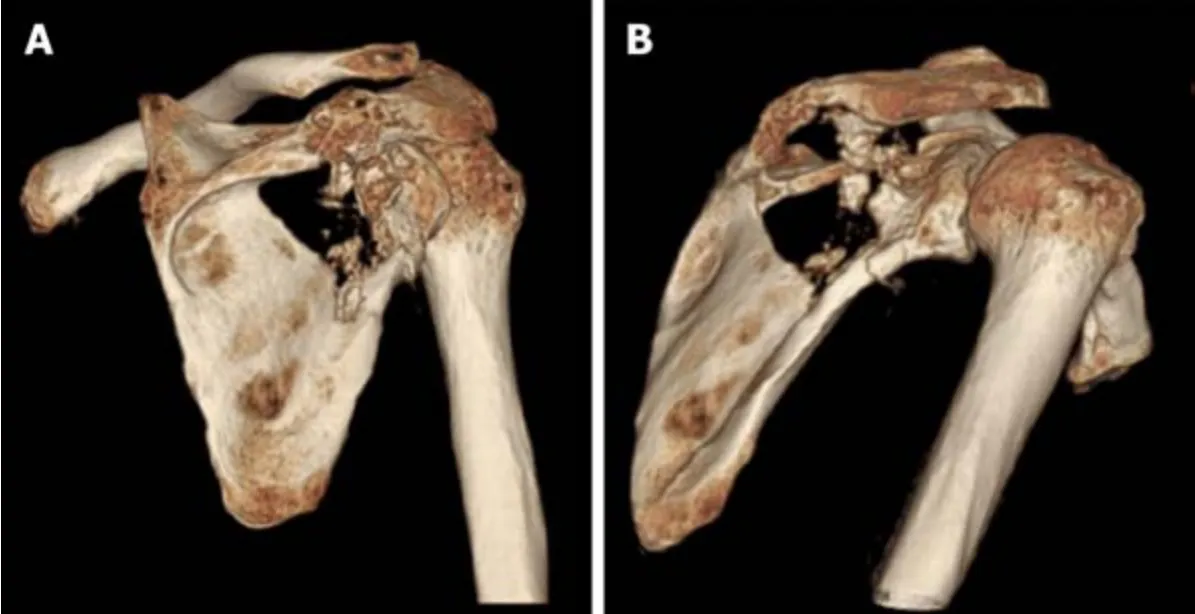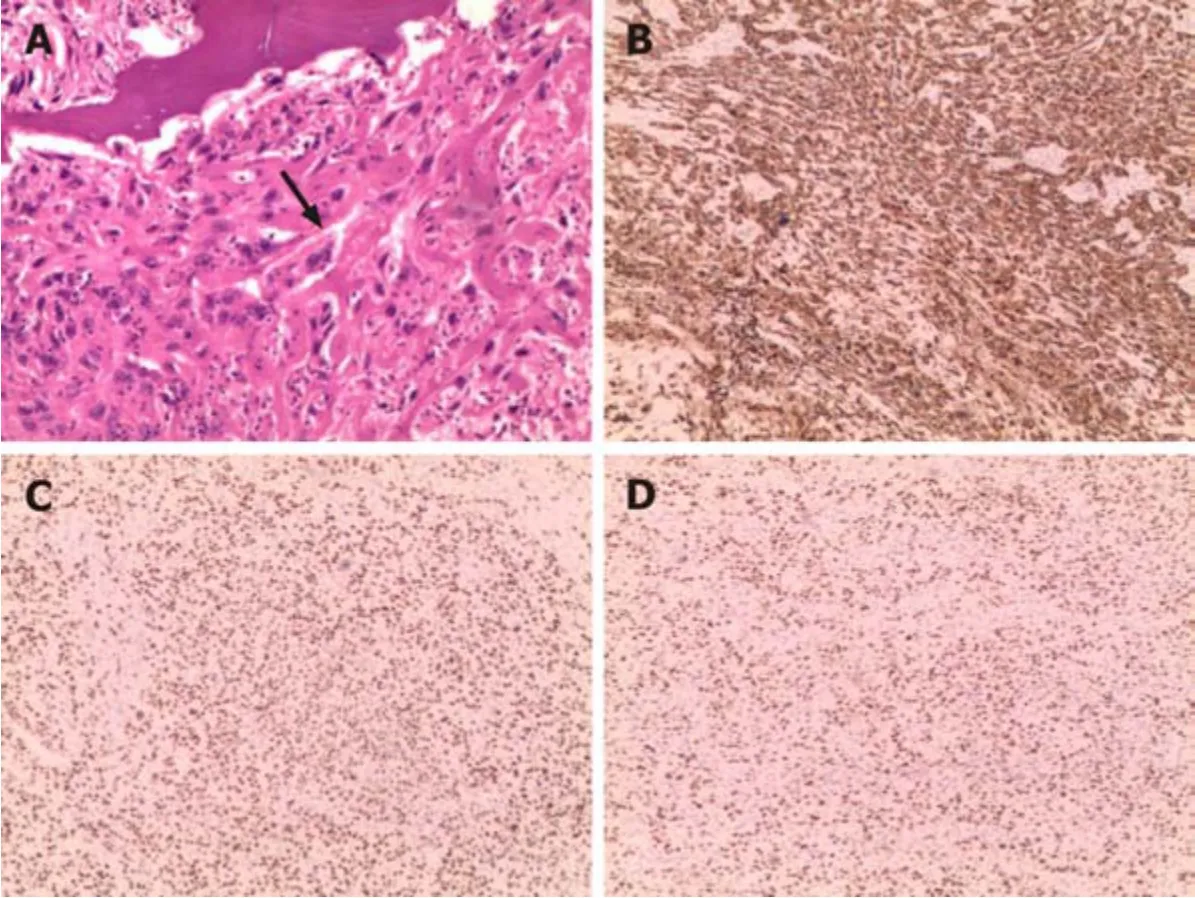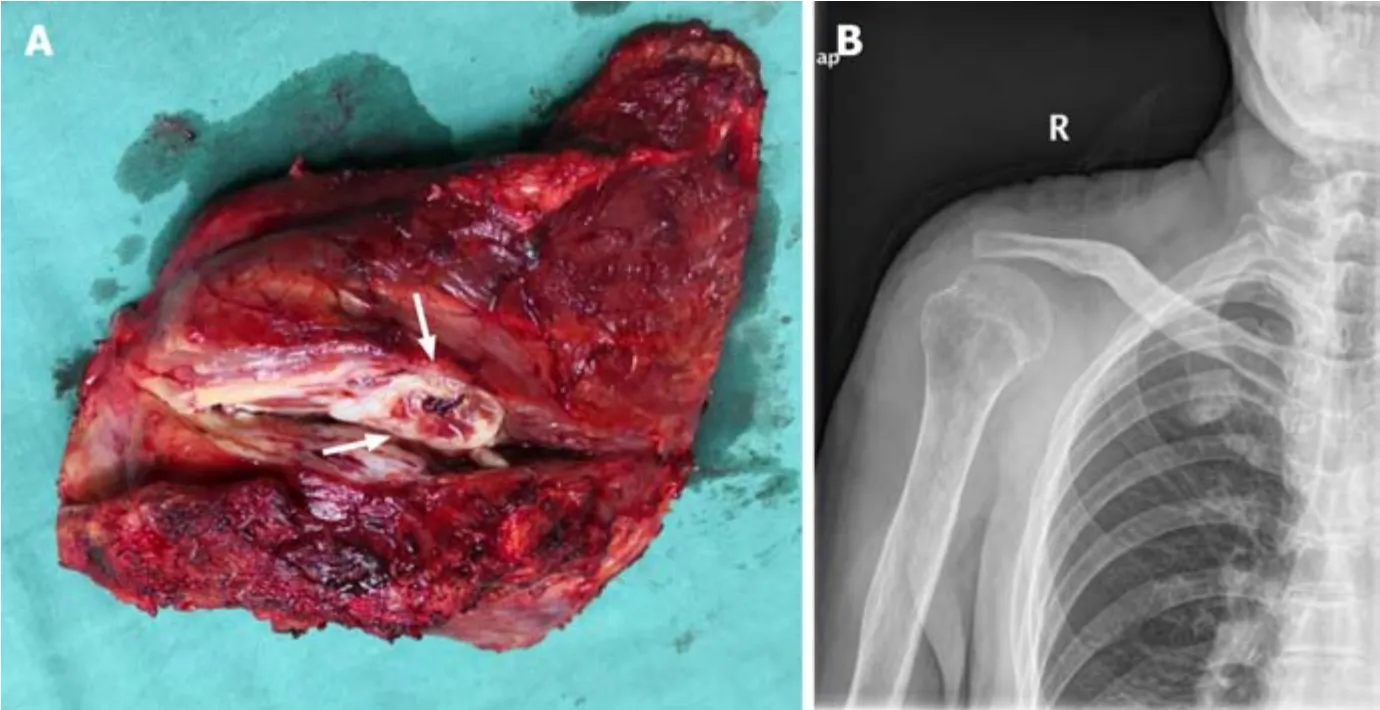Primary nonkeratinizing squamous cell carcinoma of the scapular bone:A case report
Yang Li,Jian-Lin Zuo,Jin-Shuo Tang,Sheng-Hao Xu,Jian-Lin Xiao,Department of Orthopedics,China-Japan Union Hospital of Jilin University,Changchun 130033,Jilin Province,China
Xian-Yue Shen,Department of Orthopedics,The Second Hospital of Jilin University,Changchun 130033,Jilin Province,China
Abstract BACKGROUND Squamous cell carcinoma (SCC) of bone is usually caused by metastasis from the lungs,bladder,or other sites.Primary SCC of bone most frequently involves the skull bones,and primary involvement of other sites in the skeletal system is extremely rare.To date,only three such cases have been reported,which makes the diagnosis,treatment,and prognosis of this disease a challenge.CASE SUMMARY A 76-year-old Chinese man presented to our hospital with nonspecific pain and limited mobility in the right shoulder for 4 mo.He underwent three-dimensional computed tomography reconstruction and magnetic resonance imaging of the right shoulder,which revealed an osteolytic destructive lesion in the right scapula with invasion into the surrounding muscles and soft tissues.Ultrasound-guided core needle biopsy detected a malignant tumor,and immunohistochemical analysis revealed a poorly differentiated SCC.Wide excision of the right scapular bone was performed,and pathological examination of the surgical specimen confirmed the diagnosis.At the last follow-up examination within 2 years,the patient was doing well with the pain significantly relieved in the right shoulder.CONCLUSION Primary SCC of bone is extremely rare at sites other than the skull.Clinicians must exhaust all available means for the diagnosis of primary SCC of the bone,so greater attention can be paid to its timely and effective management.Regular and adequate follow-up is essential to help rule out metastasis and judge the prognosis.
Key Words:Primary squamous cell carcinoma;Keratin pearls;Scapular bone;Diagnosis;Immunohistochemistry;Case report
INTRODUCTION
Squamous cell carcinoma (SCC) is the second most common non-melanoma skin cancer.Although SCC can metastasize to other organs such as the bones[1-4],primary SCC of the bone is rare due to the absence of native squamous epithelium in osseous tissue[5].When primary SCC does affect the bones,the most common site of involvement is the skull.Indeed,only three cases of primary SCC at other sites in the skeletal system,namely,the iliac bone,distal tibia,and tarsal bone,have been reported in the English literature[5-7].Herein,we report the fourth case of primary SCC of a nonskull bone,which is also the first case of primary nonkeratinizing SCC of the scapula.
CASE PRESENTATION
Chief complaints
A 76-year-old Chinese man experienced severe pain in the right shoulder for 4 mo,along with limitation of joint mobility.
History of present illness
The patient suffered pain and limited mobility in the right shoulder for 4 mo,without an obvious cause.Conservative treatment with oral analgesics and rest was taken by the patient;however,its effect was poor,and the pain in the right shoulder worsened.In October 2018,the patient was referred to our department for therapy.
History of past illness
The patient had a free previous medical history.
Personal and family history
The patient was a non-smoker,without relevant family history.
Physical examination
A physical examination revealed significant tenderness in the right scapula.The muscle strength of the right upper limb was grade II according to the manual muscle test classification.The range of motion of the right shoulder could not be assessed due to severe pain.
Imaging examinations
Three-dimensional computed tomography (CT) reconstruction (Figure 1) and magnetic resonance imaging revealed an osteolytic destructive lesion of the right scapula with invasion into the surrounding muscles and soft tissues (Figure 2).

Figure 1 Three-dimensional computed tomography reconstruction.

Figure 2 Magnetic resonance imaging A (t2-tse) and B (pd-tse-fs) show an osteolytic destructive lesion in the right scapular bone,invading the surrounding muscles and soft tissues.
Further diagnostic work-up
After obtaining informed consent from the patient,we performed an ultrasoundguided core needle biopsy.Histopathological examination of the core biopsy specimen revealed that it consisted of purely malignant squamous cells along.However,no typical keratin pearls were seen,as the malignant squamous cells were poorly differentiated.Therefore,a diagnosis of nonkeratinizing SCC was made.Immunohistochemical analysis showed that the tumor cells were reactive to cytokeratin 5/6,p63,p40,and vimentin (Figure 3).Furthermore,CT scans of the lungs,skull,and abdomen,single-photon emission CT-CT,and positron-emission tomography-CT confirmed that there were no other lesions outside the right scapular bone,which indicated that this was a rare presentation of a primary SCC involving the scapular bone.Therefore,the final diagnosis was primary nonkeratinizing SCC of the right scapular bone.
FINAL DIAGNOSIS
Primary nonkeratinizing SCC of the right scapular bone.
TREATMENT
The patient underwent wide excision of the right scapular bone and reconstruction of the resulting defect with the right humeral head,right collarbone,and surrounding muscles.The whole gross specimen measured 7.0 cm × 6.5 cm × 5 cm.The lesion itself was a dark red ovoid mass that originated from the right scapular bone and appeared soft and creamy-white on cross section (Figure 4).No connection to the epidermis was identified.The histopathological examination and immunohistochemical analysis of the resected specimen confirmed that it is composed entirely of malignant squamous cells.Therefore,the diagnosis was primary nonkeratinizing SCC of the right scapular bone.

Figure 3 Histological findings.

Figure 4 Primary nonkeratinizing squamous cell carcinoma of the right scapular bone.
OUTCOME AND FOLLOW-UP
Regular follow-up was continued after surgery.The postoperative course was quite good.Neither recurrence nor metastasis was found during the last 2 years of followup.The severe pain in the right shoulder was significantly relieved,and the mobility and function of the right shoulder were improved.
DISCUSSION
SCC is a tumor of the epithelial tissue that typically originates from the epithelial linings of the skin,respiratory tract,digestive tract,and reproductive tract;thus,SCC can involve the head and neck,esophagus,lungs,cervix,and genital area[8].Epithelial linings can be divided into layered squamous epithelium and non-squamous epithelium.The squamous differentiation phenotype of SCC depends on the type of oncogenic mutation involved and the cell of tumor origin,and this phenotype determines the degree of differentiation and therefore,the aggressiveness and invasiveness of these tumors[9].In the case of most cancers,the initial target cells of the oncogenic mutations as well as the number of cancer stem cells in the tumor are unknown[10].Therefore,it is difficult to know the source cells for primary SCC in the bones.SCC-derived cells share a common feature,in that they originate due to the mutation of proliferative basal cells,which are characterized by their ability to selfrenew and produce terminally differentiated cells.Under the influence of oncogenic genes,both stem and progenitor cells can act as the origin cells of cancer[8].A comparison of different SCCs shows that they are characterized by very similar mutant genes,includingTP53,SOX2,TP63,CDNK2A(P16-INK4A),NOTCH1,KMT2D,PIK3CA,andPTEN[9].
Primary SCC of bone is commonly seen in the head and neck region[11-15],and it is rarely found elsewhere in the skeletal system.According to the literature,the present case is only the fourth case ever reported of primary SCC of a bone outside the skull and the first case of a primary nonkeratinizing SCC of the scapula (Table 1).It is not easy to make a diagnosis of primary SCC of a non-skull bone,as this depends not only on pathological and immunohistochemical examinations but also requires extensive workup to rule out metastasis.In addition to metastasis,the differential diagnosis of primary SCC should also include SCC caused by chronic osteomyelitis[16-18].Keratin pearls are the pathological features of highly differentiated SCCs,and their presence in histopathological sections of well-differentiated SCCs is a common phenomenon[19].Unlike the three cases of primary SCC of a non-skull bone reported previously,our case was unique in that it had no keratin pearls.This is because our patient had a poorly differentiated SCC,while the previous three patients had well-differentiated SCCs with keratin pearl formation.The immunohistochemical features of the previous three cases were also similar to those of our case[5-7],in that the tumor cells were reactive to cytokeratin 5/6,p63,and p40[20-22].However,in our case,the tumor cells were also reactive to vimentin,which may be related to the metastasis capability and invasiveness of the primary SCC[23].In our patient,the final diagnosis of a primary SCC of the bone was supported by the immunohistochemical findings,the extensive workup for the identification of a primary source,and the fact that the patient remained disease-free during a 2-year follow-up period.
For patients with primary SCC,the choice of treatment depends on the specific tumor characteristics,and an effective personalized treatment strategy must be devised.For most patients with primary SCC of the bone without metastasis,a negative tumor margin of at least 2 cm must be achieved during surgery[24].For patients with SCC of the temporal bone,this margin may be difficult to achieve,as many important structures are located nearby,and the anatomical structure of the temporal bone is complex[25];in such patients,adjuvant radiotherapy may help control minimal residual disease[26].In our patient,as the SCC originated from the relatively independent anatomical structure of the scapula[27],it was easier to achieve complete resection of the tumor.Surgical resection is the most important treatment method for this type of tumor,and postoperative adjuvant treatment can be individualized according to the immunohistochemical characteristics of the tumor.For example,cetuximab is a monoclonal antibody that targets the epidermal growth factor receptor,and compared with conventional radiotherapy,cetuximab combined with radiotherapy may help achieve good outcomes in some patients with SCC[28].In addition,cisplatin,5-fluorouracil,and docetaxel is an effective combination chemotherapy regimen[29].These adjuvant treatments can improve local control and reduce the mortality of advanced head and neck cancers,but due to the paucity of reports of primary SCCs outside the head and neck,there is still a lack of effective clinical research evidence.
CONCLUSION
To the best of our knowledge,this report is the first to describe primary nonkeratinizing SCC of the scapular bone.However,there is still no consensus on the standard treatment method or prognosis of primary SCC of non-skull bones because of its rarity,with only a few cases having been reported and followed up.Our findings demonstrate that clinicians must exhaust all available means for the diagnosis of primary SCC of bones,so greater attention can be paid to timely treatment andeffective management.Regular and adequate follow-up is essential to help rule out metastasis and judge the prognosis.

Table 1 Published cases of primary squamous cell carcinoma of bones outside the skull
 World Journal of Clinical Cases2021年4期
World Journal of Clinical Cases2021年4期
- World Journal of Clinical Cases的其它文章
- Isolated interrupted aortic arch in an adult:A case report
- Fertility-sparing surgeries without adjuvant therapy through term pregnancies in a patient with low-grade endometrial stromal sarcoma:A case report
- Acute inferior wall myocardial infarction induced by aortic dissection in a young adult with Marfan syndrome:A case report
- Immediate implant placement in combination with platelet rich-fibrin into extraction sites with periapical infection in the esthetic zone:A case report and review of literature
- Pheochromocytoma as a cause of repeated acute myocardial infarctions,heart failure,and transient erythrocytosis:A case report and review of the literature
- Renal failure and hepatitis following ingestion of raw grass carp gallbladder:A case report
